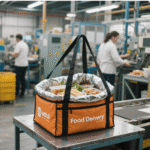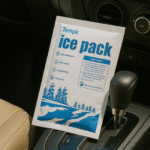Dry Ice Pack for Shipping Food (2025 Guide)
-
What a dry ice pack is—and when food shippers should use it
-
Dry ice vs. gel vs. PCM (for food lanes)
-
Sizing the charge (with a fast formula & examples)
-
How to pack frozen food with dry ice (step‑by‑step)
-
2025 regulations you must meet (air & baggage)
-
Food‑specific best practices (qualité & sécurité)
-
Handling, disposal & worker safety
-
Durabilité: lower‑carbon options for your program
-
FAQ
-
References & next steps
1) What a paquet de glace sec is—and when food shippers should use it
UN dry ice pack/packet is sealed solid CO₂ that cools by sublimation (~−78.5 °C / −109 °F). It keeps cartons dry (no meltwater) and enables deep‑freeze lanes for glace, fruit de mer, viande, and ready‑to‑eat frozen meals during transit windows of 24–72 h depending on insulation and charge. Use it when your target hold ≤−20 °C or you need “frozen hard” delivery without powered refrigeration.
2) Dry ice vs. gel vs. PCM (for food lanes)
| Cooling option | Typical hold temp | Pros | Cons | Best for |
|---|---|---|---|---|
| Dry ice pack | Source ~−78.5 °C; supports ≤−20 °C | Deep‑freeze headroom; no water | Class 9 DG; needs venting & labels | Frozen foods (glace, fruit de mer), long lanes |
| Gel pack | ~0 to −10/−20 °C | Simple, réutilisable, non‑DG | Limited cold depth | Chilled perishables, short lanes |
| PCM pack | Tuned setpoints (Par exemple, 2–8 °C, −20 °C) | Tight control; réutilisable | Upfront cost; poids | Pharma foods or lanes not needing −78.5 °C |
This comparison consolidates your draft’s structure and aligns with common cold‑chain practice.
3) Sizing the charge (rapide)
Règle: Expect 5–10 lb of dry ice to sublimate per 24 h in a properly insulated shipper. Ajouter +25% buffer for hot weather, weekend dwell, or multi‑stop routes.
Formula:Dry ice (lb) = (Transit hours ÷ 24) × (5 to 10)
Worked examples (food focus):
-
Glace, 36 h, medium EPS shipper: 10–15 lb; place packs above payload; add +3 lb buffer for summer Friday dispatch. UPS
-
Fruit de mer, 48 h, premium vacuum‑panel shipper: 12–20 lb; add data logger; instruct consignee on safe venting on receipt. UPS
Why above the load? CO₂ gas is heavier than air; top‑loading helps cold gas flow across the food evenly.
4) How to pack frozen food with dry ice (step‑by‑step)
-
Pre‑chill the insulated container.
-
Bag & seal food (vacuum/pouches) to prevent freezer burn and odor transfer.
-
Add a separator (tray/pad) so food doesn’t touch dry ice directly.
-
Lieu dry ice packs on top of the food space.
-
Vent the shipper—never airtight.
-
Mark & label:
-
Proper shipping name + UN #: “Carbon dioxide, solid (Dry ice), UN 1845”
-
Poids net (kg) of dry ice on each package
-
Class 9 hazard label
-
-
Ajouter temperature logger et SOP insert for the receiver.
5) 2025 regulations you must meet (air & baggage)
-
Air cargo (non‑DG contents cooled by dry ice): Follow IATA Packing Instruction 954. Key checks include vented packaging, correct marks/labels, net weight in kg, and a per‑package max of 200 kg dry ice. Acceptance checklists were updated for 2025 (66th ed.).
-
Passenger & crew baggage: A different rule (Tableau 2.3.UN) permits ≤2.5 kg of dry ice per person if the baggage can vent; baggage must be marked “dry ice” and show net mass or “2.5 kg or less.”
-
Carrier/operator variations: Carriers (Par exemple, FedEx) publish 2025 DG dry‑ice checklists—verify before tender.
Always reconcile state/operator variations and declare properly on the Air Waybill; incorrect marking is a common delay cause.
6) Food‑specific best practices (qualité & sécurité)
-
For mail‑order food: Use a sturdy box, choose glace carbonique for frozen goods, et warn the recipient on the outer carton; avoid direct food contact.
-
Avoid under‑insulation: If the payload is not meant to freeze (Par exemple, chilled bakery), use gel/PCM instead of dry ice.
-
Follow PHMSA/US DOT guidance for any perishable package likely to move by air legs.
7) Handling, disposal & worker safety
-
EPP: Use insulated/cryogenic gloves and eye protection; never bare‑hand dry ice.
-
Ventilation: 1 lb of dry ice releases ~250 L CO₂—risk of oxygen displacement in confined spaces; open and stage in ventilated areas.
-
Élimination: Let dry ice sublimate in a ventilated area; never in sinks or sealed bins.
-
Training: Ensure anyone preparing paperwork or packouts for air transport is trained on IATA/DOT rules.
8) Durabilité: lower‑carbon options for your program
-
CO₂ recovery at pelletizers: Modern recovery systems capture vented CO₂ during production and recycle it back to liquid—cutting liquid CO₂ use by ~50% in many installs and reducing scope‑related impacts.
-
Biogenic CO₂ sourcing: Where available, biogenic/captured CO₂ streams (Par exemple, from fermentation/biogas) can lower lifecycle impact relative to fossil sources.
-
Right‑sizing & hybrids: Replace some lanes with PCM panels where frozen‑hard isn’t required; keep dry ice for truly ultracold/frozen lanes.
-
Good practice: Understand environmental aspects around dry‑ice/CO₂ facilities and implement operational controls.
9) FAQ
Q1. How much dry ice do I need to ship frozen food for 48 h?
Plan 10–20 lb total (5–10 lb per 24 h) depending on insulation; add +25% buffer for heat or delays. Place packs on top.
Q2. What labels are mandatory on the box?
Mark “Carbon dioxide, solid (Dry ice), UN 1845”, add net weight (kg) on each package, and apply the Class 9 label; packaging must secouer.
Q3. Can I fly with dry ice in checked baggage?
Yes—if the bag can vent and you carry ≤2.5 kg per person with required marking (see IATA Table 2.3.A).
Q4. Is dry ice safe for food shipments?
Oui, when isolated from direct contact, vented, and handled with EPP; it keeps foods deeply frozen without water mess.
Q5. How do I dispose of leftover dry ice on delivery?
Let it fully sublimate in a well‑ventilated area away from people and pets; never put it in sinks or sealed containers.
10) References & next steps
-
Iata 2025 Acceptance Checklist (PI 954, marks & 200 kg limit)—use it to pass acceptance first time.
-
UPS dry‑ice guidance (5–10 lb/24 h rule)—baseline sizing for food shippers.
-
Baggage rule (2.5 kg/pax)—IATA Table 2.3.A excerpt.
-
Sécurité (PPE/venting; 250 L CO₂ per lb)—OSHA & university EHS summaries.
-
USDA/FSIS mail‑order food tips—consumer‑safe delivery practices.
























